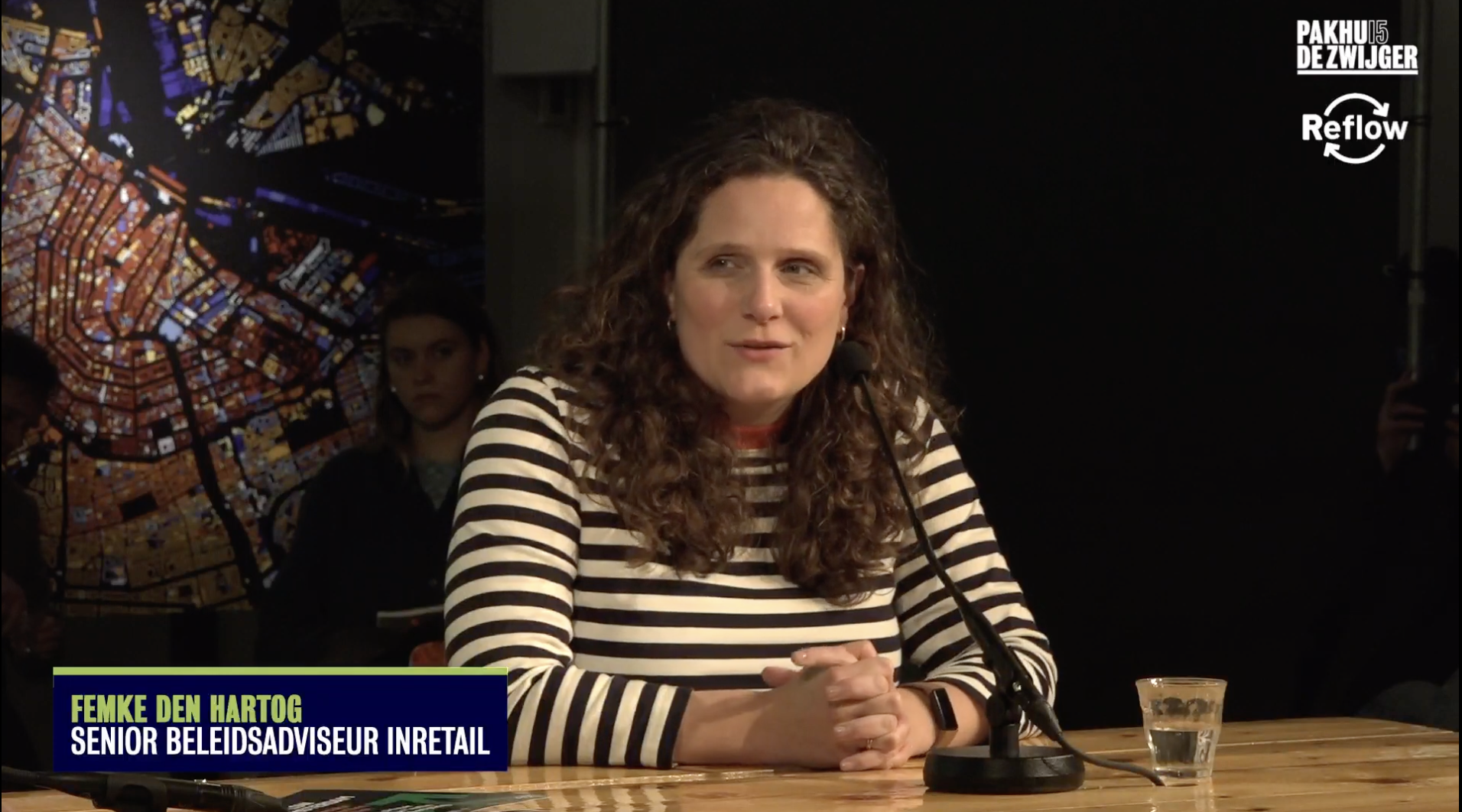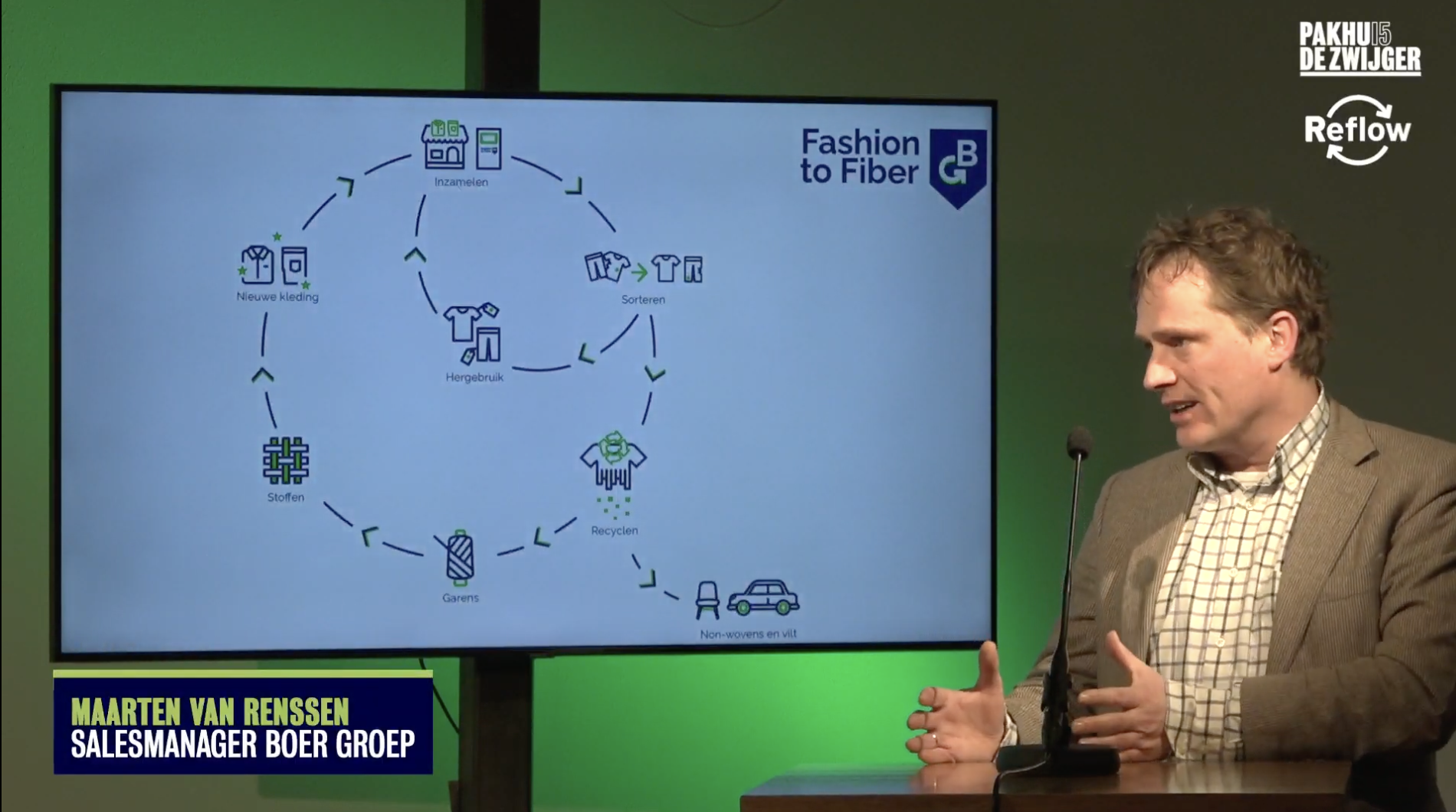
9 December 2025
Niki de Schryver from COSH!: Fast fashion harms circular goals
- Greenwashing
- Press
Did you know that the European Union is introducing rules for extended producer responsibility (EPR) starting in 2023? By doing so, they want to encourage the reuse of clothing and create less waste and pollution. This is necessary because the clothing industry is enormously polluting and the average European says goodbye to about 11 kilos of textiles per year.
The EPR Garment producers, importers and online shops will be responsible for the collection, processing and recycling of discarded textiles. In this way, a lot less textiles will end up on the waste mountain and the circular circle can be closed.
Pakhuis de Zwijger organized a livecast In cooperation with Reflow, “Textile Mountain seeks owner”. In it they pointed out that only 1% of the collected textiles are recycled into new textile products. The goal of the European Extended Producer Responsibility (EPR) is to increase this percentage to 20% by 2030.
Annet Feenstra, Peter Koppert, Femke den Hartog, Marten Boels, Maarten van Renssen, Janine Röling and Caroline Poot spoke about their experiences with how brands and companies in the Netherlands are already working on their places in a circular future during the Pakhuis de Zwijger livecast.

Femke den Hartog, Senior Policy Advisor for INretail spoke at Pakhuis de Zwijger and said it is important for the industry to work together. “We have to look at what happens to collected textiles and take up the challenge collectively. At the start of the process, recycled fibers should be used for new clothing and afterwards we need to make sure that more and more textiles are reused or recycled.“
Innovations such as new recycling techniques are essential during this transition. “If you buy a refrigerator you pay dismantling costs, for textiles we would like the same. A small contribution per textile piece to pay for innovation and sorting.” Den Hartog says this contribution will not lead to extreme price increases. “Think in cents rather than euros.”
In addition, den Hartog points to a change in consumer mentality. “If people start looking at textiles differently, wearing them for longer and are willing to repair them (or have them repaired), the waste mountain will be smaller regardless.”
COSH! tip: Did you know that the municipality of Amsterdam has a promotion where you get a discount at several tailors if you are in possession of the Stadspas? This gives people with a low income the chance to have their clothes repaired. Read more about this great initiative via this link.
What can we expect when we go shopping in the stores? Den Hartog: “More attention to materials, quality and longevity of clothing and second-hand items among the new collections.” COSH! tip: There are already stores that have a second-hand offer in addition to their offer of new clothing. Be sure to check out The Collection One, with its own handpicked vintage, Tally-Ho with an assortment provided by Serendipity Vintage Dreamer in Amsterdam and the Seventy One stores in Belgium.

Annet Feenstra is a sustainability manager at H&M. In their store on Amsterdam’s Kalverstraat, H&M started renting out, repairing and personalizing clothes, while in North Amsterdam they introduced a second-hand concept.
Feenstra notes that more and more consumers are becoming familiar with circular initiatives such as selling and swapping clothes. “I hope that people get the (sentimental) value of being able to wear your clothes again. When you recognize that value, you are also more willing to invest in repairs.”
H&M is a big company. “That’s why we can force a breakthrough, but even we can’t do it alone. We need a European EPR, it’s difficult when every country has different legislation and goals.”
H&M sees the need to create a fully circular product life cycle. Starting with the design phase. “This is where choices are made that already have an impact on pollution and recyclability.” Feenstra says recycling techniques need to be improved and scaled up as well as investing into innovative materials.

Caroline Poot is the CSR manager at the JOG Group. With the denim deal, they want to increase the amount of recycled cotton in denim. They are launching their most sustainable jeans to date, with 20% post-consumer recycled cotton.
Post-consumer recycled means the cotton has been worn or used by the consumer before. “Using a higher percentage than 20% recycled cotton is difficult because it wears out faster and the fabric feels rougher.” To make the jeans recyclable even after use, they mix the recycled cotton with new cotton, replace the nails with embroidery and laser the labels. “For collection we have Drop & Loop boxes in the stores, they recycle everything in-house with Wolkat.”

Janine Röling is a researcher at the environmental organization Recycling Netwerk Benelux and thinks that the new regulations are a potential game changer, but the government needs to ensure proper enforcement and a different role for producer organizations. These organizations make agreements with collectors and recycling companies, among others, to successfully implement the EPR as part of environmental policy.
Röling: “And that’s exactly where the problem lies, we often see that producer organizations have a guiding role in addition to executive and social roles and influence the government. That is bad because we have seen in other sectors that they can work against environmental policy.”
Based on those findings, Röling recommends that research on goals and governance be conducted by the government. “In order to achieve proper regulation of the EPR, they could, for example, set up an independent advisory group. If there is a representative consideration from the beginning, environmental policy can be implemented optimally.”

Peter Koppert is sustainability & innovation manager for entrepreneurial organization Modint, he is preparing his supporters for the new EPR. “We want to give the EPR a boost and set up a producer organization to consult with different stakeholders, for a realistic but ambitious plan. It would be great if the circular revolution starts in Amsterdam.”
Koppert says there needs to be a better connection between waste and recycling. “There is an end to the life of clothing. Any longer than 5 to 10 years, and clothing is usually not wearable. That’s why recycling is an important tie-in.”
If a company can show that they have used recycled content, it should be rewarded, Koppert says. “If you’re part of the solution, there should be tax breaks associated with that. In France, they’ve had such a system for ten years.”
According to Koppert, the EPR should not be seen as being too local and should be rolled out predominantly in the Netherlands and Europe. “Local initiatives are the stepping stones. By tackling it on a large scale, we can avoid most of the waste.”

Maarten Renssen is sales manager at the collection and sorting company Boer Group and is concerned with improving textile collection and ensuring that as few textiles as possible end up in residual waste. “We set up Fashion to Fiber to help retailers with clothing collection,” he says.
“Textiles are collected and sorted for what is reusable and what is recyclable. That part of the process has to happen in the Netherlands. What happens to the clothing must be communicated transparently to retailers or customers. For example, that 80% of the garment was recycled and used for a certain product.”
To achieve that transparency comes with a condition, says Renssen. “If we collect from the municipality in bulk, it won’t work; we just need collection points.”
Boer Group receives support from the Amsterdam municipality. “Amsterdam is an important point in the Netherlands and Europe in terms of circular textiles. There is a lot of economic activity here.” Renssen hopes that Amsterdam’s sustainable frontrunners of today, will be positively supported by the EPR. “We need to do research on yarns to be able to use more and more recycled content, that takes time and money.”
According to Renssen, the greatest impact can be made by first rolling out the EPR with work apparel. “To make the system affordable, upscaling is important.”

Marten Boels works within the MRA on the circular economy as raw materials director. He is concerned with developing and stimulating circularity for raw materials in the Amsterdam metropolitan region.
“We would all like to have transparency in the textile chain but this is difficult to achieve. By collaborating with the municipality of Amsterdam, we are able to get a better understanding of what is in the textile bins and what we can do with it. We want to know where the textile goes when it has been collected.”
Legislation around the EPR is on the way, on a national and European level. If you want to know more about the Dutch extended producer responsibility and the roadmap outlined for it, read this blog.
There are already fashion entrepreneurs who take some responsibility themselves regarding the “end life” of their product. For example, they have a repair service or return service to give the clothes a new life.
Other initiatives that extend the life of clothing include clothing libraries like LENA Library, local second-hand initiatives such as the Swapshop, the giveaway store New Life West and brands that upcycle like Archivist Studio.
Find more circular stores in Amsterdam through our shopping guides and discover tailors where you get a discount with the Amsterdam City Pass here.

9 December 2025

9 December 2025

9 December 2025